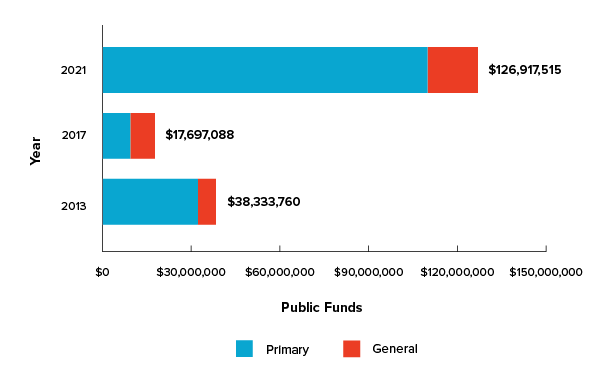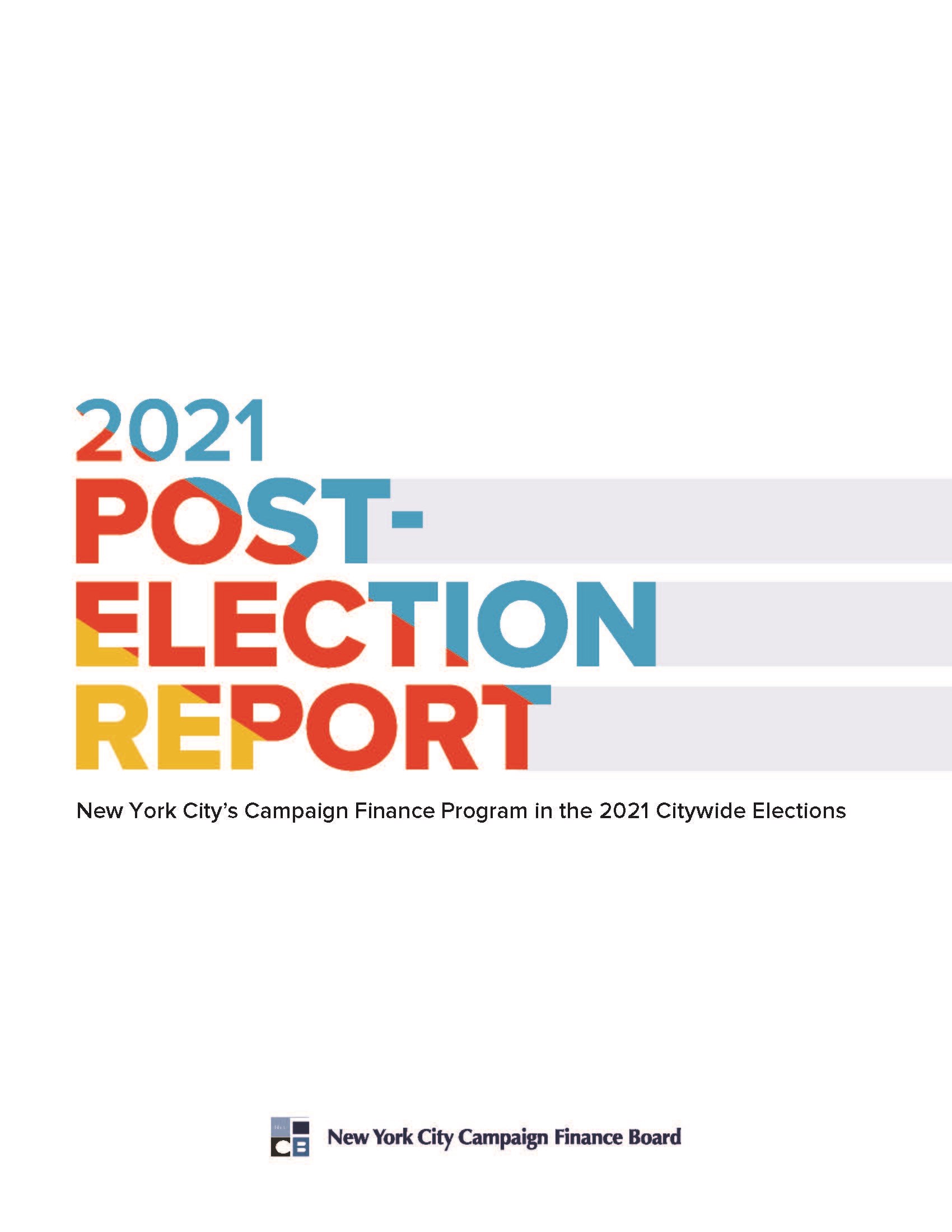Statistics and charts about the 2021 election in NYC, including an analysis of the public matching funds program.
The Post Election Report for 2021 includes a comprehensive analysis of the campaign finance program’s effect on the 2021 city elections, a closer look at first-time participants, the Campaign Finance Board’s (CFB) online fundraising platform (Contribute), outside spending, audit and enforcement measures, and policy recommendations to improve the program. The tabs on this page include an executive summary and additional context for the full PDF report.
The 2021 election cycle was yet another record-breaking year for New York City’s campaign finance program. Over the course of the 2021 election, $126.9 million in public funds was paid to 308 candidates, matching nearly $18.3 million in contributions from New Yorkers. This was more than three times the total amount paid in 2013, the previous open citywide election.
Along with significant changes to the matching funds program, high participation rate by candidates on the ballot for the primary and general elections helped drive this high payout of public funds. Compared to 2013, 3.0% more primary election candidates and 19.0% more general election candidates participated in the public matching funds program.


These candidates took advantage of the public matching funds program by raising most of their contributions from small donations and New York City residents:
- Small-dollar contributions made up a vast majority of candidate fundraising with small contributions making up 84.6% of contributions in the primary and 79.0% in the general. This compares to 65.7% of contributions in the 2013 primary election and 62.5% of contributions in the 2013 general election.
- Most individual contributions were given by New York City residents – 71.6% of primary contributions and 70.1% of general election contributions. In 2013, only 66.2% of primary election contributions and 67.7% of general election contributions were given by individual New York City residents.
First-time payees
A primary mission of the CFB includes reducing barriers to running for office, with special attention paid to women and candidates of color due to the systemic challenges they face when running for office. Comparing first-time payees to program veteran candidates provides an opportunity to examine whether new candidates have equal access to the matching funds program.
This analysis included findings such as:
- The majority of first-time payees come from areas of the City that are already highly privileged (whiter, wealthier, more educated neighborhoods).
- There is no clear advantage to being a program veteran.
- First-time payees and program veterans raised about the same in individual contributions ($39,533 vs. $42,325).
- There is no statistically significant difference between the percentage of first-time payees and program veterans who received max payments.
- There is no true difference in candidate spending between first-time payees and program veterans.
- The majority of districts with the largest percentage of candidates not meeting the threshold are in Council districts in upper Manhattan and outlying areas of other boroughs.
- To further this analysis, in future reports we hope to analyze whether certain demographic, geographic, and social factors make a candidate running for office more or less likely to qualify for public funds.
NYC Votes Contribute
NYC Votes Contribute is a one-of-a-kind online credit card processing platform created as a public resource to serve all candidates for city office. Contribute helps candidates meet CFB-specific compliance requirements and also allows campaigns to easily collect credit card contributions, which made up 86.4% of individual contributions in 2021. Within the last several years, credit cards have replaced checks as the most popular way to contribute.
- Likely because it is free to use, Contribute is a more popular platform for City Council candidates (who face lower spending limits) than for Mayoral candidates. However, 93.9% of all candidates in the 2021 election cycle used Contribute to raise contributions. Candidates who received public funds were more likely to use Contribute over those who did not receive public funds (98.9% vs. 90.0%).
- Contributions made through the Contribute platform were less likely to be under $25 than donations that come from a different credit card processing platform. Our analysis found that this likely was due to default donation options, which can have a considerable influence on people’s donation choices; the choices on Contribute default to start at $25 instead of a lower amount like $10. On other credit card processing platforms the most popular contribution amount is $10, whereas it is only fourth most popular on Contribute.
- The Contribute platform also helped candidates comply with CFB documentation and disclosure requirements. City Council candidates who received more of their contributions through Contribute were found to have fewer findings or violations.
Independent Expenditures Analysis
For the past 10 years, the CFB has received and reviewed disclosures of fundraising and spending by independent spenders. Since then, independent spending has increased significantly and the disclosure rules for independent expenditures have become more robust. By overseeing and enforcing authority on this type of spending, the Campaign Finance Board can view spending patterns and ensure that this information is accessible for the public.
This report covers critical independent spending trends and matters such as:
- The monumental increase of digital advertising spending, which jumped from $453,778 in 2013 to $6.3 million in 2021.
- The small amount of spending on negative messaging, as less than 1.0% of all communications distributed by spenders in the 2021 Mayoral race were negative.
- The top ten single-candidate entities supporting or opposing Mayoral candidates in 2021, who accounted for 77.0% of total independent spending in the Mayoral race.
Post-Election Audit and Enforcement of 2017 Election Cycle
The CFB’s robust audit process ensures that candidates receiving public funds use them in a lawful manner and that all campaigns comply with universal requirements such as contribution limits.
Of those campaigns audited by the CFB after the 2017 elections: 62.0% did not receive any penalties, and of those who did, a majority were penalized less than $5,000. Overall this indicates that most candidates are successfully complying with the CFB’s Rules and campaign finance law.
The post-election report traditionally includes recommendations to ensure the Campaign Finance Act continues to adapt to changes in how money is raised and spent in elections.
The 2018 Charter Revision Commission proposed three changes to the matching funds program that were included as recommendations in the 2017 Post Election Report (PER). All three changes passed in a 2018 ballot proposal, drastically changing the program through reduced contribution limits and an increased matching rate. This, along with Ranked Choice Voting and the pandemic, means that New York City elections have seen a lot of changes within the past few years. It is prudent to wait for data from the 2023 and 2025 elections before revisiting some of these changes to ensure that any further modifications are based on solid factual evidence.
This report includes two recommendations on how the State Legislature can change the relevant campaign finance sections of the Election Law:
Recommendation #1: Prohibit campaigns from receiving cryptocurrency donations Cryptocurrency should not be an accepted contribution method because of the unnecessary risk it poses to our compliance and enforcement regulations.
Recommendation #2: Eliminate potential foreign influence on ballot proposals Foreign entities should not be able to spend money that is unregulated on local or state ballot proposal campaigns.
For a complete view of the dashboards, visit nyccfb.info/2021stats.
During the 2021 election, $126.9 million in public funds was paid to 308 candidates, matching nearly $18.3 million in contributions from New Yorkers.
The following dashboards visualize the CFB’s campaign finance data, while offering comparisons between districts and offices, and summarizing the 2021 election cycle. We’ve divided up the visualizations into 3 distinct dashboards - one for City Council races, one for Borough President races, and one for the three citywide races of Mayor, Public Advocate, and Comptroller. Only candidates who were listed on the primary or general election ballot are included.
For a complete view of the dashboards, visit nyccfb.info/2021stats.










